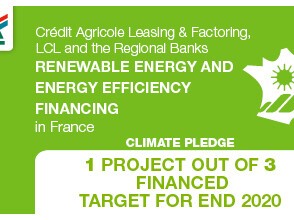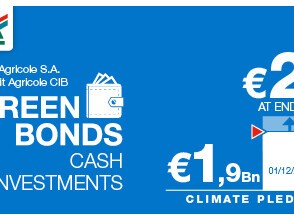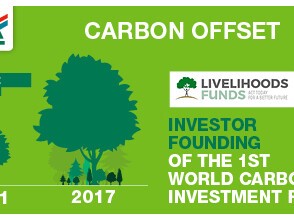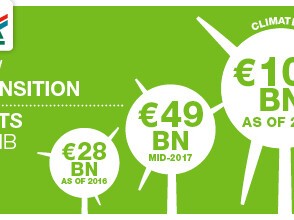
07-12-2017
Climate financing: Crédit Agricole S.A. is taking its commitments further
Two years after the Paris Agreement on climate change, the Group has decided to extend and clarify the commitments it made in 2015 by increasing green financing, including climate issues in risk assessments, excluding hydrocarbons that cause the most damage to the environment and offsetting its entire direct carbon footprint.

CREDIT AGRICOLE HAS A CRUCIAL ROLE TO PLAY IN LEADING THE ECONOMY IN THE ENERGY TRANSITION
With its deep-rooted history as a "green" bank, Crédit Agricole has a crucial role to play in facilitating the energy and carbon transitions. It takes a realistic but thorough approach to helping its clients transform over time by providing appropriate innovative solutions. Philippe Brassac, Chief Executive Officer of Crédit Agricole S.A., explained, "We are accompanying progress: our role is to accelerate the energy transition and to support, through our expertise, our customers in changing their business models. In order to be efficient, our commitments must be precise and technical”
CREDIT AGRICOLE S.A. NEW COMMITMENTS:
- To arrange €100bn in green financing around the world by 2020. Crédit Agricole is extending the commitment it made at the COP21 to arrange €60m in green financing by 2018.
- To finance one in three renewable energy and energy efficiency projects in France by 2020. With this measure, Crédit Agricole intends to double financing for renewable energies in France.
- To take into account climate issues in our risk assessments of large clients and their projects, as of the end of 2017. We will gradually extend this process to other client categories.
- To exclude the least energy efficient hydrocarbons and those that pose the greatest threat to the environment, because these are incompatible with the goal of combating climate change and they represent an economic risk for investors. In particular, this commitment covers:
- All oil sands projects,
- All oil extracted from the Arctic region (off-shore and on-shore production),
- Shale gas or oil production involving excessive flaring or venting,
- Infrastructure projects mainly intended for schemes covered by the exclusion criteria set out above,
- To offset Crédit Agricole S.A. entire direct carbon footprint until 2040 via the Livelihoods carbon fund.
Appendix 1: Our commitments in detail
- Extending the commitment made at the COP21 to arrange €60bn in green financing around the world to €100bn by 2020 (Green Bonds and Green Loans by CA-CIB),
- In France, financing one in three renewable energy and energy efficiency projects by 2020 (CA Leasing & Factoring – Unifergie with the regional banks and LCL),
- Adding Climate issues to the Environment, Social and Ethics criteria already applied in the procedures we use to assess the risk profile of our large clients and their projects,
- In its sector policies, the Group is updating the oil and gas and shale gas policies it has applied since 2012 with additional technical requirements aimed at excluding the least efficient hydrocarbons and those that pose the greatest threat to the environment, because these are incompatible with the goal of combating climate change and they represent an economic risk for investors. The exclusion applies to:
- Techniques that are the least energy efficient and that generate the most harmful emissions. This means all extra heavy oil projects (API gravity[1] of 10 degrees or less), regardless of the extraction method used. In particular, this includes all oil sands projects. Extra heavy oil accounts for over half of estimated global resources (source Schlumberger 2016 Oilfield Review). Also, all gas-to-liquids projects,
- All oil extracted from the Arctic region, whether off-shore (already excluded since 2012) or on-shore,
- Shale gas or oil production involving excessive flaring or venting. This adds to the requirements imposed by Crédit Agricole since 2012 in terms of consulting local communities and managing water responsibly.
- Infrastructure projects mainly intended for schemes covered by the exclusion criteria set out in the CSR policy - Oil and Gas sector. These include, but are not limited to, processing plants, utilities (electricity, water, industrial gas, etc.), pipelines, storage and distribution facilities,
- Continuing to reduce and offset the entire direct carbon footprint of Crédit Agricole S.A. and its subsidiaries until 2040 via the Livelihoods carbon fund.
Livelihoods aims to improve living conditions in rural communities in developing countries through carbon funds. Its funds finance projects including reforestation initiatives, the restoration of damaged ecosystems, agro-forestry activities and small-scale rural energy production. These projects provide local people with sustainable economic growth while offering shareholders carbon credits. The second Livelihoods carbon fund, in which Crédit Agricole S.A. has decided to invest, aims to raise €100 million. It intends to prevent the emission of 25 million tonnes of CO2 and to improve living conditions for over 2 million people. We are inspired by the results obtained by the first Livelihoods carbon fund over 5 years: 1 million beneficiaries in the poorest communities in developing countries; 130 million trees planted covering an area equivalent to five times the size of Paris; 120,000 families equipped with efficient cooking stoves that reduce their use of wood, limit deforestation and improve women's health by removing toxic smoke from their homes; 10 million tonnes of CO2 captured or avoided over time (the projects last between 10 and 20 years).
Appendix 2: Initiatives taken since 2003
A long standing and pioneering commitment :
- For many years, Crédit Agricole has been involved in the setting up of major initiatives such as the Equator Principles in 2003, the Climate Principles in 2008 and the Green Bond Principles in 2014. We have also helped develop best practice, in particular by financing renewable energies since the late 1990s, publishing the carbon footprint of our financing activities since 2011 and applying sector policies for activities having a significant potential environmental or social impact since 2012,
- The Group's everyday commitment has led to the development of financial engineering solutions and a careful allocation of our resources to ensure we play a decisive leading role in combating climate change (Green Bonds and Green Loans for CA-CIB, Amundi Green Bonds and low-carbon funds, investments in renewable energies at CAA, expertise for CA Leasing & Factoring – Unifergie and a commitment by the local banks and LCL to finance renewable energies in France and to finance energy efficiency renovations by businesses and individuals, etc.),
- Crédit Agricole is a world leader in structuring Green Bonds,
- More generally, we help all our clients adopt more energy- and carbon-efficient business models and work with them to redirect financing away from activities that damage the climate and the environment and towards more sustainable business activities (ESG-climate risk policy and sector policies),
- Crédit Agricole was also a pioneer with its sector policies, in particular by moving out of the coal sector from May 2015 and by excluding off-shore oil production in the Arctic from 2012.
[1] API (American Petroleum Institute) gravity measures the density of oil (10° = extra heavy; 60° = very light).


EN_TwitterCard_RNE.jpg
06-12-2017

EN_TwitterCard_GreenBonds.jpg
06-12-2017

EN_TwitterCard_CarbonOffset.jpg
06-12-2017
Our press contact

Alexandre Barat
Responsable Relations Presse Crédit Agricole S.A.




